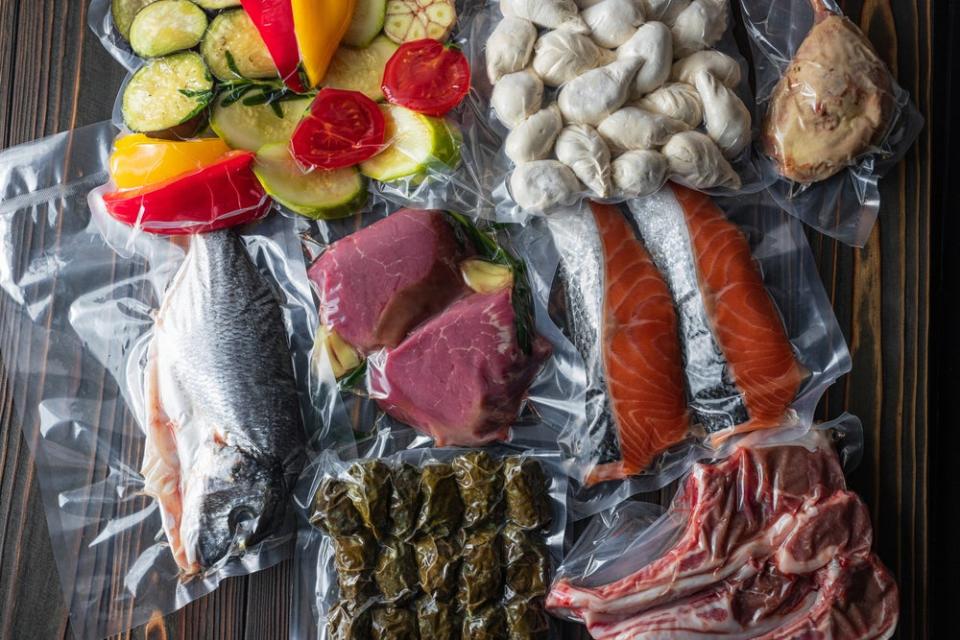Vacuum packaging: a fresh approach to sustainability

In a world increasingly concerned with sustainability and efficiency, vacuum packaging emerges as a crucial technology in food preservation and waste reduction.
Alcimed's latest report shines a light on this method's benefits, both for public health and the environment, as vacuum packaging revolutionises the way we store and transport food.
Ensuring food quality and safety
Vacuum packaging primarily serves to extend the shelf life of food by removing air from the package, significantly reducing oxygen levels. This absence of oxygen is key in preventing the growth of aerobic microorganisms such as moulds and bacteria, which can lead to food spoilage.
Moreover, it helps in maintaining the food's organoleptic properties—its taste, texture, and nutritional value—which are often compromised in other preservation methods such as heat treatment.
The technology behind vacuum sealing is straightforward yet effective. Food items are placed in specially designed bags or containers from which the air is evacuated before sealing.
This method not only keeps food edible for up to five times longer than traditional storage methods but also ensures that the food's nutritive qualities are not degraded by oxidation.
This process is beneficial not just for storage but also complements other food preservation techniques, such as pasteurisation or freezing, enhancing their effectiveness while potentially reducing the need for chemical preservatives.
Reducing food waste
Globally, nearly a third of all food produced is discarded, according to Alcimed’s report. This statistic highlights a severe inefficiency in our food supply chain and represents a substantial environmental and economic issue.
Vacuum packaging directly addresses this problem by improving the shelf life of food products, which in turn reduces the likelihood of food being thrown away.
In recent years, vacuum sealing technology has become more accessible to the average consumer, with affordable and easy-to-use machines now available for home use.
These devices allow individuals to store perishable items more effectively, thereby reducing personal food waste. Furthermore, the options for consumers now include not only single-use plastic bags but also reusable containers that offer a more sustainable choice.
Streamlining logistics and reducing energy use
Vacuum packaging also plays a pivotal role in the logistics of food distribution, especially for foods that need to be transported over long distances or internationally.
By extending the freshness of products without the need for constant refrigeration, vacuum packaging can reduce the energy required to maintain the cold chain during transport.
This method is particularly beneficial for "climacteric" fruits like mangoes and pineapples, which are often harvested before they are fully ripe to endure long shipping durations.
With vacuum packaging, these fruits can be allowed to ripen and then sealed, maintaining their quality and reducing the need for energy-intensive air transport.
Furthermore, by limiting exposure to the air, vacuum packaging can prevent maceration—a common issue during the container shipping of fruits and vegetables caused by fluctuations in temperature and humidity.
This not only reduces waste but also improves the energy efficiency of shipping these goods.
Seizing the opportunity for further environmental benefits
As we grapple with the dual challenges of environmental sustainability and efficient food distribution, vacuum packaging offers a viable solution that tackles both.
It extends food freshness, reduces waste, and lessens our reliance on energy-consuming preservation methods. With ongoing advancements in sustainable and reusable packaging options, the potential for further environmental benefits is significant.
The journey towards more sustainable food systems is complex and multifaceted, but innovations like vacuum packaging play a crucial role.
"Vacuum packaging: a fresh approach to sustainability" was originally created and published by Packaging Gateway, a GlobalData owned brand.
The information on this site has been included in good faith for general informational purposes only. It is not intended to amount to advice on which you should rely, and we give no representation, warranty or guarantee, whether express or implied as to its accuracy or completeness. You must obtain professional or specialist advice before taking, or refraining from, any action on the basis of the content on our site.

 Yahoo Finanzas
Yahoo Finanzas 